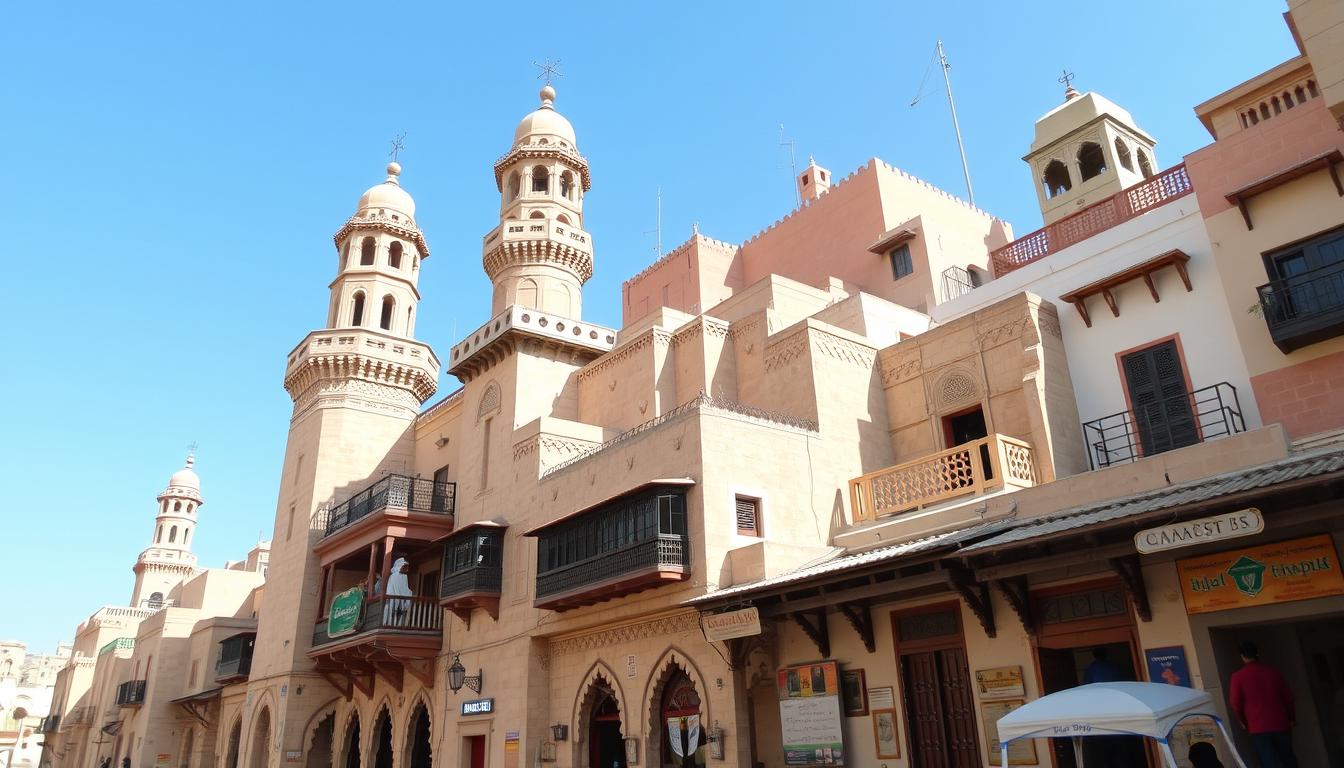
- 1.4k Views
- 7 Min Read
- (0) Comment
When I entered the Al Fahidi Historical District, it was like stepping back in time. Dubai’s origins as a modest trading hub were evident in every narrow alley. These pathways seemed to share ancient tales, urging me to dive into its secrets.
Each turn revealed a new wonder. I was mesmerized by the beautiful ancient architecture and lively art galleries. They showed how Emirati culture has evolved. This visit felt like traveling through history, letting me experience Dubai’s rich heritage. Amidst the historical sites and quaint cafes, I found the true spirit of the city and its people.
The Dubai Museum is amazing and only charges AED 3 for adults. It deepened my connection with the local community and heritage. And the Coffee Museum? It’s incredible, with over 300 antique pieces and a warm setting. Enjoying a traditional coffee here, I felt closely tied to the culture that treasures this drink. The Al Fahidi Historical District is more than a tourist spot. It warmly welcomes you to be part of its extraordinary story.
Key Takeaways
- The Al Fahidi Historical District, also known as Al Bastakiya, showcases Dubai’s transformation.
- Traditional Emirati architecture features narrow winds and twisting pathways.
- Museums like the Dubai Museum and the Coins Museum offer affordable access.
- Art galleries and cultural centers highlight the vibrant local art scene.
- The Sheikh Mohammed Centre for Cultural Understanding enhances appreciation of Emirati traditions.
Introduction to the Al Fahidi Historical District
The Al Fahidi Historical District is a key piece of Dubai’s heritage. It shows off the city’s rich past. This area is alive with culture, thanks to its old streets and long history. It started in the 1800s with Persian merchants. The district features beautiful buildings in traditional styles. Walking here feels like stepping into old Dubai.
This area is open for everyone to enjoy without paying. It’s great for families and tourists who love adventure! It’s open every day from 7:00 AM to 8:00 PM. There’s plenty of time to explore. Being close to the Dubai Museum makes it even better. This adds a mix of history and art to your visit.
Getting to the Al Fahidi Historical District is easy. You can take metro line M2 or several bus lines. It’s close to big bus stops. So, visiting other places nearby is simple. And, you can try tasty Emirati food at places like Al Khayma Heritage Restaurant. This is perfect for before or after your visit.
See the amazing buildings and hear local stories. The locals are keen to share their culture. The Al Fahidi Historical District is a hidden treasure. It’s an important part of Dubai’s story.
History of the Al Fahidi Historical District
The Al Fahidi Historical District has an inspiring story of growth and change. It all started in the 19th-century Dubai. This area was shaped by Persian merchants who valued its strategic spot by the Dubai Creek. They made Al Fahidi a key place for trading goods like textiles and spices, which boosted the region’s economy.
Origins and Establishment in the 19th Century
Al Fahidi dates back to the early 1800s. At that time, Dubai was just beginning to grow. Persian merchants set up a lively marketplace here, creating a bustling atmosphere. The area became known for its trade and culture, drawing in goods and people from many places. It grew to reflect Emirati culture, highlighting the mix of different communities.
Transformation through Key Events
Several important events have shaped Al Fahidi over the years. The discovery of oil in the 1930s was a turning point for Dubai, leading to fast urban growth. Even though Al Fahidi almost got demolished in the 1970s, a group of conservationists worked hard to save it. Thanks to them, the neighborhood was preserved, keeping it an important piece of Dubai’s cultural story.
Now, visitors can wander through Al Fahidi and feel its special charm. You can visit the Dubai Museum to see artifacts and learn about the souks. Imagine the Persian merchants and the buzzing trade hub they created. For those looking to dive into Dubai’s cultural past, Al Fahidi is a great place to start. Find out more about what you can experience by visiting this link.
Architectural Wonders of the District
The Al Fahidi Historical District shows off the gorgeous traditional Emirati architecture. Its beautiful buildings and cultural landmarks draw you in. As you walk the winding paths, you see old buildings made of coral, stone, and gypsum. These structures have a design that is both useful and beautiful.
Each building proves the skill of Emirati builders, made to handle the desert heat. They have cooling systems that make indoors bearable.
Features of Traditional Emirati Architecture
The designs in the district do more than just look pretty. They have important features:
- Courtyards: They offer private outdoor areas that help with airflow and privacy.
- Intricate carvings: The decorations show local heritage and craftsmanship.
- Thick walls: Built to keep out the desert heat and keep it cool inside.
- Wooden balconies: They provide shade and nice views.
Significance of Wind Tower Houses
Wind tower houses, or “barjeels,” stand out in the district. They’re natural air conditioners. Here’s why they matter:
- They grab the slightest breeze to cool the building naturally.
- Their design is all about living sustainably, showing how old methods can beat the heat.
- These houses are a testament to the amazing local artisans, mixing beauty with practicality.
As you explore, you feel the heart of traditional Emirati culture. The beautiful designs and the coolness of the wind tower houses make every moment in the Al Fahidi Historical District unforgettable. It’s like stepping into the charm of old Dubai!
| Feature | Description |
|---|---|
| Courtyards | Private outdoor spaces enhancing natural ventilation and privacy. |
| Intricate Carvings | Decorative motifs reflecting local heritage and artistry. |
| Thick Walls | Constructed to withstand desert heat, providing cooling insulation. |
| Wooden Balconies | Shaded areas offering beautiful views of the surroundings. |
| Wind Tower Houses | Natural ventilation structures representing sustainable living and craftsmanship. |
Exploring the Cultural Heritage
As you explore the Al Fahidi Historical District, you’ll get a glimpse into Emirati culture and traditions. This area is more than just beautiful historic buildings. It’s a place where community events and culture come alive. Talking with locals is a great way to experience Emirati hospitality.
Every chat is a chance to learn about their customs. You can also join cultural activities. These experiences highlight the rich heritage of this proud people.
Emirati Culture and Traditions
In Dubai, the traditions show the warmth and generosity of Emirati culture. Sharing stories or taking part in customs enriches your visit. It’s a way to truly understand the people and their heritage.
To deepen your experience, check out museums and art galleries. They are key to this vibrant cultural atmosphere.
Museums and Art Galleries
The Al Fahidi District is where you’ll find important Dubai museums. The Dubai Museum in Al Fahidi Fort shows the city’s journey from a small fishing village. It’s grown into the bustling metropolis it is today.
Art galleries in Al Fahidi, like the XVA Gallery, display works by local and international artists. This introduces you to Dubai’s current artistic scene. For more cultural experiences, visit this link. Your adventure in Al Fahidi will be memorable.
FAQ
What is the Al Fahidi Historical District known for?
The Al Fahidi Historical District, also known as Al Bastakiya, is famous for its rich Emirati culture and ancient buildings. It shows how Dubai changed from a small trading town to a big modern city. You can see traditional markets, old landmarks, and amazing museums there!
How can I explore Emirati culture in the Al Fahidi Historical District?
To explore Emirati culture, you can join heritage tours and talk with the locals. Visit places like the Dubai Museum. There are lots of cultural activities to enjoy. It’s a great way to learn about local traditions!
What are wind tower houses, and why are they significant?
Wind tower houses in the Al Fahidi District are special because of their design. They kept homes cool before air conditioning was around. These towers show the clever skills and green ways of living of early Emirati people!
Are there any traditional markets or souks in Al Fahidi?
Yes, Al Fahidi has many traditional markets where you can buy fabrics, spices, and crafts. Shopping here lets you feel a part of Dubai’s lively trading past. It’s a real treat for your senses!
Why is the Al Fahidi Historical District a must-visit for tourists?
Visiting the district is a must because it combines heritage, old architecture, and lively culture. It’s perfect for tourists and families looking for adventure. You’ll discover interesting stories, see art, and experience warm welcomes. These memories will last a lifetime!
Categories
- Uncategorized (4)
- Desert Buggy Rental (1,397)
- Dune buggy (4)
- Quad Bike Rental (1)
- Desert safari (1)
- Hot air ballon (2)
- dirt bike (4)
Recent Post
Tags
Abu Dhabi desert safari weather conditions Abu Dhabi outdoor family activities Adventure Tours Dubai Adventure tours near Dubai Sports City Arabian desert exploration Beach activities in Ajman Buggy Safari Experience Burj Khalifa quad biking tour Currency conversion rates Desert Adventure Tours Desert Adventure Trails Desert Driving Tips Desert Dune Bashing Desert Exploration Tours Desert safari buggy rides Desert Safari Enhancements Desert safari experiences Desert Safari Thrills Desert Thrills in Dubai Discovery Gardens Dubai Dubai adrenaline experiences Dubai Desert Dune Bashing Dubai Group Tours Dubai Investment Park Activities Dubai to Hatta Dubai water canal dhow cruise Dune Buggy Experience Dune buggy rides Group Quad Biking Tours Honeymoon Desert Adventures Marine wildlife encounters Middle Eastern safari excursions Nomadic traditions Off-road buggy ride Off-road riding attire Off-Road Vehicles Outdoor experiences Dubai Planning a desert safari from Palm Jumeirah Private Luxury Tours Road trip excursions UAE desert safari UAE dune buggy rentals UAE Dune Buggy Rides UAE travel tips Yachting lifestyle



